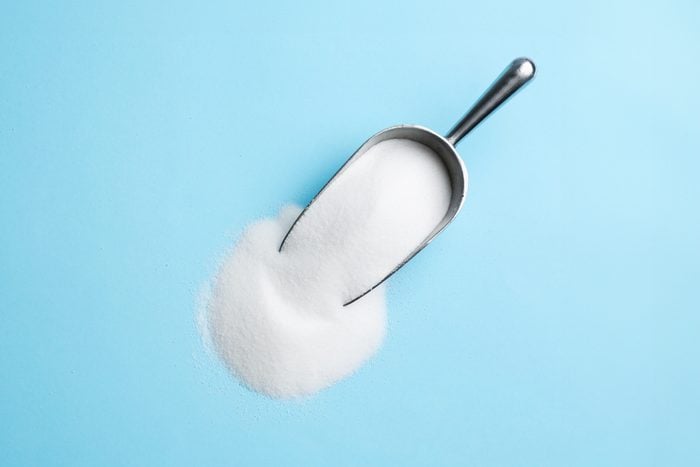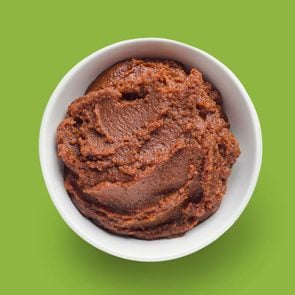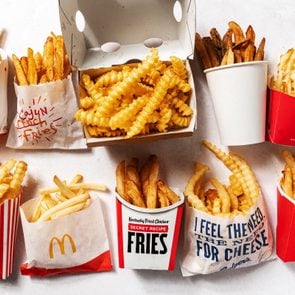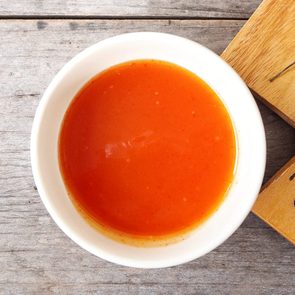What Exactly Is MSG—and Is It Really Bad for You?
Updated: Oct. 17, 2023

Learn what the flavor enhancer MSG really is, what foods it's found in—and what risks may be associated with it
Just what is MSG, and what does it stand for? MSG is short for monosodium glutamate, and it’s a flavor enhancer commonly added to Chinese food, canned vegetables, soups and processed meats. It’s also part of a larger group of chemicals called glutamates. “MSG contains glutamic acid, which is also naturally found in tomatoes, parmesan cheese, meat, walnuts, clams, sardines, mushrooms and other foods,” says Emily Rubin, RD, the head dietitian for the celiac and fatty liver centers at Thomas Jefferson University in Philadelphia. Read on for more food facts about MSG, including whether it’s safe to include in your diet, and what foods tend to include the additive.
What is MSG used for?
MSG is added to foods to enhance their savory or umami quality. Umami is a fifth flavor category, joining sweet, sour, salty and bitter, according to the Academy of Nutrition and Dietetics. You can check the ingredient list on the labels of prepared foods to see if they contain MSG.
What does MSG taste like?
MSG has no texture or smell. It simply enhances a food’s natural flavor, as opposed to adding a new one, and tends to be most flavor intensifying when used in poultry, seafood, meats and some vegetables.
What is MSG made of?
In a nutshell, MSG is produced by fermenting starch, sugar beets, sugar cane or molasses. Fermentation is the process by which yeast or bacteria convert carbs into alcohol. This is the same process used to make yogurt and other healthful fermented foods.
Where did MSG come from?
A Japanese scientist first isolated MSG from seaweed soup in 1908 and noted its flavor-enhancing properties. He then filed a patent to produce MSG, which led to commercial production of the flavor enhancer. Decades later, the controversy started, notes the U.S. Food and Drug Administration (FDA). In 1968 a brouhaha ignited when a biomedical researcher wrote to the editors of the New England Journal of Medicine citing a strange illness he developed after eating at Chinese restaurants—specifically those that cooked with MSG. His symptoms included numbness, weakness and heart palpitations and became known as “Chinese Food syndrome.” Despite the lack of social media at the time, the letter went viral. Soon after its publication, everyone turned on MSG, and a flurry of research on its health effects began.
There has been controversy as to whether some people develop symptoms such as headaches, muscle aches and tingling after consumption of MSG, according to Rubin. “There has been no definitive evidence of a link between MSG and these symptoms,” she says. Despite this, some 50 years after the syndrome was first named, U.S. consumers still say they avoid MSG, according to the International Food Information Council, an industry-funded group.
Is MSG safe?

The FDA says that MSG is “generally recognized as safe” (GRAS). The watchdog group requires that foods containing added MSG list it on the ingredient panel as monosodium glutamate. If MSG is found naturally in some of the ingredients (hydrolyzed vegetable protein, autolyzed yeast, hydrolyzed yeast, yeast extract, soy extracts and protein isolate), the manufacturer does not have to list MSG on the label. That said, those foods cannot say “No MSG” or “No added MSG” on their packaging. MSG also cannot be listed as generic spices and flavoring. Speaking of packaging, here’s a guide to decoding the colored circles on food packages.
Why do people think MSG is bad?
Some people may be sensitive to the additive and experience swelling in the throat and other symptoms when they consume a lot. Some experts, including Michael Galitzer, MD, an integrative medicine specialist and co-author of Outstanding Health: A Longevity Guide for Staying Young, Healthy, and Sexy for the Rest of Your Life, believe the flavor enhancer is dangerous: “Its ingestion can cause inflammation of the small intestine, referred to as leaky gut, which will result in symptoms such as bloating, gas, diarrhea and abdominal pain,” says Dr. Galitzer. If you’d like to know more, these signs suggest you may have a leaky gut.
How much MSG is safe?
Most research suggests you’d have to eat more than 3 grams of added MSG in a sitting to experience adverse effects—that’s according to a 2019 review of studies published in the journal Comprehensive Reviews in Food Science and Food Safety. The FDA explains that a typical serving of a food with added MSG contains less than 0.5 grams of MSG and that Americans consume about that much daily, on average. “MSG is generally found in processed foods. If your diet is filled with fresh, whole foods, your MSG intake is low,” says Rubin.
Is MSG gluten-free?
Yes, according to the National Celiac Foundation. There may be starches or sugars used in fermenting MSG, but wheat starch—which contains gluten—is not one of them. Even if wheat starch were used to make MSG, it is highly unlikely that the end-product would contain traces of gluten. They further clarify by stating that a person with celiac disease may react to the wheat in soy sauce, but not the MSG, for example.
Does MSG cause headaches?
MSG has been linked to headaches—including a debilitating migraine headache—but this link is far from conclusive. In fact, some research suggests MSG does not increase the risk of migraines. These findings were presented by the headache information site Curelator at the 2018 Annual Scientific Meeting of the American Headache Society. In January 2018, the International Headache Society struck MSG from a list of causative factors for headaches. If you do suffer from frequent headaches, here are foods that do make headaches worse.
Does MSG make you sleepy?
The FDA states that drowsiness may occur in some people who are sensitive to MSG and consume 3 grams or more of the flavor enhancer. “MSG is controversial, and the research has been inconsistent, but there are MSG-sensitive people, and for them, it can trigger headaches, migraine, numbness and extreme fatigue,” says Robin Foroutan, RDN, an integrative medicine dietitian at the Morrison Center in New York City and a spokesperson for the Academy of Nutrition and Dietetics. “I generally recommend that people with tendencies for headaches, migraine and fatigue avoid it.”
What types of food tend to have added MSG?
Soy sauce is a common one, according to Foroutan, saying that “it’s best to read the ingredient list if you want to avoid it.” Here are some more foods that might have added MSG:
- Chips and other snack foods
- Seasoning blends
- Canned soups
- Frozen foods
- Processed meats (jerky, deli meats, hot dogs, sausages)
Fast food and MSG
At one time, it was easy to find MSG in fast-food restaurants, but more and more chains are eliminating the flavoring. Here’s the lowdown on some popular fast-food chains and whether they use MSG.
Does McDonald’s use MSG?
None of the items on McDonald’s core U.S. menu contain added MSG, but a handful of test and regional items in the United States do contain added MSG, a McDonald’s spokesperson confirmed.
Does Panda Express use MSG?
This popular Chinese restaurant does not add MSG to any of its dishes, but some ingredients may contain natural MSG, according to the corporate website.
Does Chick-fil-A use MSG?
MSG is present in some of Chick-fil-A’s menu options, but they also offer a variety of choices that do not contain added MSG, states Chick-fil-A, Inc.
Does Burger King use MSG?
The burger chain has dropped the flavoring from all its foods.
Does Subway use MSG?
The popular sandwich chain doesn’t add MSG to any of the items on its standard menu.
Does Domino’s use MSG?
The pizza delivery chain does not add MSG to any of its food.
Could MSG be good for you?
Consuming umami-rich broth may promote healthy eating behaviors and food choices, especially in women at risk of obesity, according to a study in Neuropsychopharmacology. Researchers evaluated changes in the brains of women after they consumed chicken broth with or without MSG. The broth with added MSG lit up areas of the brain connected to satisfaction and better eating control, the researchers discovered. What’s more, women who had the broth made better choices during their meal, favoring foods with less saturated fat.
“Our study suggests the possibility that people at high risk of obesity could benefit from an umami-rich broth before a meal to facilitate healthy eating and healthy food choice,” says Miguel Alonso-Alonso, MD, PhD, an assistant professor at the Center for the Study of Nutrition Medicine in Beth Israel Deaconess Medical Center in a news release.
“In Western and European cuisine, flavor is built by adding fat,” says Carlene Thomas, RDN, a dietitian and author of The Wedding Wellness Workbook: Your Nutrition How-To Before “I Do.” This includes butter, heavy cream and cheese. “For those struggling with calorie consumption, using umami to season rather than fat could help with healthy weight management,” she says.
MSG can also be a major tool in helping to reduce salt intake, Thomas adds. “The use of umami allows for less salt, specifically for MSG. That means sodium levels can be reduced while maintaining or improving the taste of a product,” she explains. (Check out more things you probably don’t know about salt.)
About the experts
- Emily Rubin, RD, is the head dietitian for the celiac and fatty liver centers at Thomas Jefferson University in Philadelphia.
- Robin Foroutan, RDN, is an integrative medicine dietitian at the Morrison Center in New York City and a spokesperson for the Academy of Nutrition and Dietetics.
- Miguel Alonso-Alonso, MD, PhD, is an assistant professor at the Center for the Study of Nutrition Medicine in Beth Israel Deaconess Medical Center.
- Carlene Thomas, RDN, is a dietitian in the Washington, D.C., area and author of The Wedding Wellness Workbook: Your Nutrition How-To Before “I Do.”
- Michael Galitzer, MD, is an integrative medicine specialist in Los Angeles and author of Outstanding Health: A Longevity Guide for Staying Young, Healthy, and Sexy for the Rest of Your Life.
Sources:
- Academy of Nutrition and Dietetics: “Umami”
- U.S. Food and Drug Administration: “Questions and Answers on Monosodium glutamate (MSG)”
- Food Insight: “Newsbite: Why Are Americans Still Avoiding MSG?”
- New England Journal of Medicine: “Chinese-Restaurant Syndrome”
- Comprehensive Reviews in Food Science and Food Safety: “A Review of the Alleged Health Hazards of Monosodium Glutamate”
- Curelator, Inc.: “American Headache Society: New Curelator Data Questions Popular Belief That Many Common Foods Act as Migraine Triggers”
- Washington Post: “Burger King wants you to watch a Whopper consumed by mold. It’s a new ad campaign. Seriously.“
- Domino’s: “Food FAQs”
- Panda Express: “Orange Chicken”
- Neuropsychopharmacology: “Neurocognitive effects of umami: association with eating behavior and food choice”




